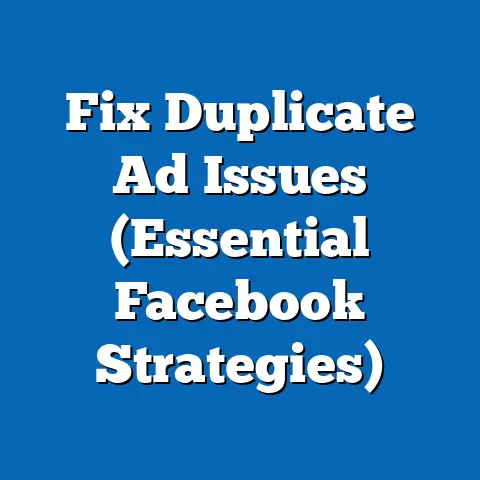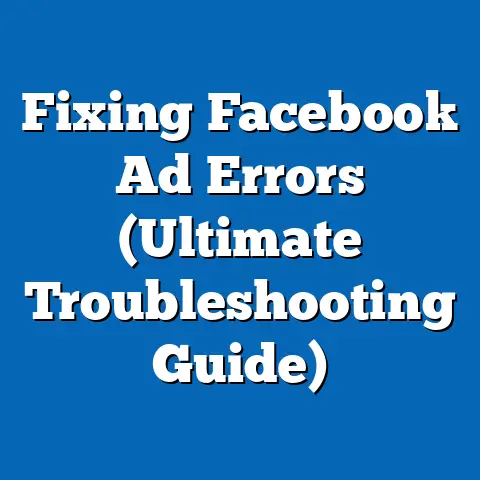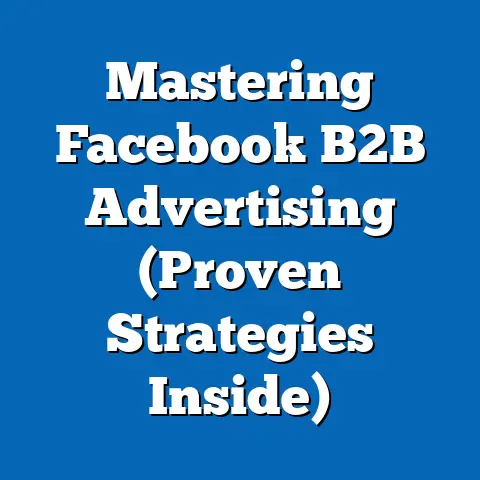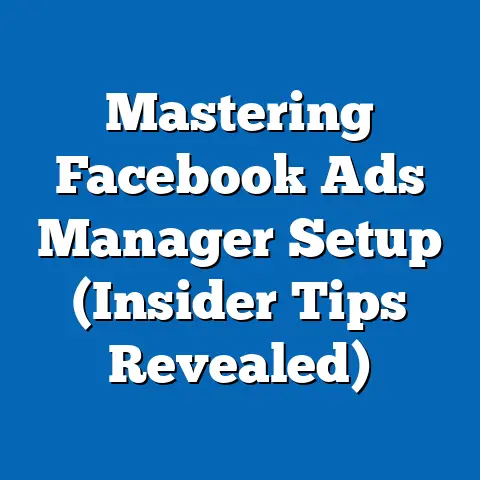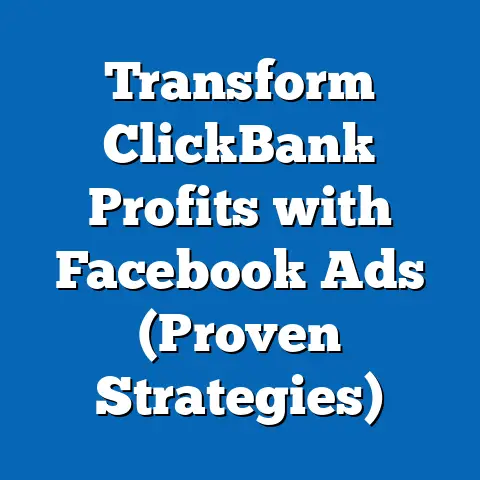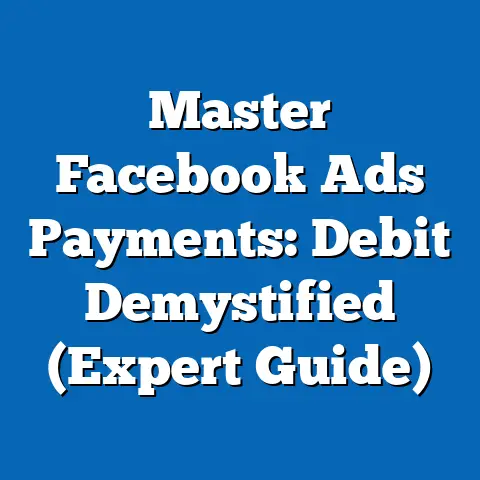Maximize Reach: Advertise on Facebook Posts (Expert Guide)
Have you ever scrolled through Facebook and wondered why some businesses seem to effortlessly capture your attention, while others fade into the background noise? Or maybe you’ve even run Facebook ads yourself, only to be disappointed by the lackluster results. The truth is, cracking the code to successful Facebook advertising isn’t about luck; it’s about strategy, understanding your audience, and leveraging the platform’s powerful tools. In this expert guide, I’ll walk you through everything you need to know to maximize your reach and make your Facebook ads truly effective.
Understanding Facebook as a Marketing Platform
Facebook has come a long way from its humble beginnings as a social network for college students. Today, it’s a global advertising powerhouse, connecting businesses with billions of potential customers. I still remember when businesses were hesitant to embrace Facebook as a marketing channel, viewing it primarily as a place for personal connections. Now, it’s almost unthinkable for a business not to have a Facebook presence.
Over the years, Facebook’s advertising capabilities have evolved dramatically. From simple sidebar ads to sophisticated, data-driven campaigns, the platform offers a wide array of tools for businesses of all sizes. The key is understanding how to use these tools effectively.
Here are some current statistics that highlight Facebook’s marketing potential:
- User Base: Facebook boasts nearly 3 billion monthly active users as of early 2024. This massive audience provides unparalleled reach for advertisers.
- Engagement: The average user spends a significant amount of time on Facebook each day, increasing the likelihood of ad exposure.
- Demographics: Facebook’s diverse user base spans a wide range of demographics, making it possible to target specific audience segments based on age, gender, location, interests, and more.
- Advertising Revenue: Facebook generates billions of dollars in advertising revenue each quarter, demonstrating the platform’s effectiveness for businesses.
What sets Facebook apart from other social media platforms like Instagram, Twitter (now X), or LinkedIn is its unparalleled targeting capabilities. Facebook’s extensive user data allows advertisers to create highly specific audience segments, ensuring that their ads are seen by the people most likely to be interested in their products or services. This level of precision is what makes Facebook advertising so powerful.
Key Takeaway: Facebook’s massive user base, diverse demographics, and sophisticated targeting capabilities make it a powerful platform for businesses looking to expand their reach and connect with potential customers.
The Importance of Maximizing Reach
In the world of Facebook advertising, “reach” refers to the total number of unique people who see your ad. It’s not just about the number of impressions (how many times your ad is displayed), but the number of individual users who are exposed to your message. Maximizing reach is crucial for several reasons:
- Brand Awareness: A wider reach means more people are familiar with your brand, products, or services. This is particularly important for new businesses or those looking to expand into new markets.
- Customer Engagement: Reaching a larger audience increases the chances of sparking conversations, generating leads, and building relationships with potential customers.
- Conversion Rates: While reach alone doesn’t guarantee sales, it sets the stage for conversions. By exposing your message to a wider audience, you increase the likelihood of finding qualified leads who are ready to buy.
I’ve seen firsthand how a well-executed campaign focused on maximizing reach can transform a business. I worked with a local bakery that was struggling to attract new customers. By creating engaging Facebook ads that showcased their delicious pastries and targeting a broad audience within their local area, we were able to significantly increase their brand awareness and foot traffic. Within a few months, they saw a noticeable boost in sales.
Here are a few examples of successful campaigns that prioritized reach:
- Dollar Shave Club: Their viral video campaign, which was initially promoted on Facebook, reached millions of potential customers and helped them disrupt the shaving industry.
- Old Spice: Their “The Man Your Man Could Smell Like” campaign used personalized videos and interactive content to engage a massive audience on Facebook and other social media platforms.
- Airbnb: Their targeted Facebook ads, which highlighted unique travel experiences and local hosts, helped them reach a global audience and establish themselves as a leading player in the hospitality industry.
These examples demonstrate that maximizing reach isn’t just about quantity; it’s about quality. It’s about creating engaging content that resonates with your target audience and sparks their interest in your brand.
Key Takeaway: Maximizing reach on Facebook is essential for building brand awareness, fostering customer engagement, and ultimately driving conversions.
Crafting Effective Facebook Ads
Creating effective Facebook ads is both an art and a science. It requires a deep understanding of your target audience, a knack for crafting compelling copy, and an eye for visually appealing design. I always tell my clients that their ads are a conversation starter, not a sales pitch.
Here are the key components of a successful Facebook ad:
- Visuals: Your visuals (images or videos) are the first thing people will notice, so they need to be eye-catching and relevant to your message. High-quality images and videos that showcase your product or service in an appealing way are essential. I’ve found that user-generated content often performs exceptionally well, as it feels more authentic and relatable.
- Copy: Your ad copy should be concise, engaging, and persuasive. Highlight the benefits of your product or service and explain why people should care. Use a clear and compelling headline to grab attention and encourage people to read further.
- Call-to-Action (CTA): Your CTA tells people what you want them to do next. Use strong action verbs like “Shop Now,” “Learn More,” or “Sign Up” to encourage clicks and conversions. Make sure your CTA is prominently displayed and easy to find.
Understanding your target audience is paramount. Before you even start creating your ads, take the time to research your ideal customer. What are their interests, needs, and pain points? What kind of language do they use? What kind of visuals do they respond to? The more you know about your target audience, the better you’ll be able to tailor your ads to meet their preferences.
A/B testing, also known as split testing, is a powerful technique for refining your ads and improving their performance. The idea is simple: create two versions of your ad (with slightly different visuals, copy, or CTAs) and run them simultaneously. By tracking which version performs better, you can identify the most effective elements and optimize your ads accordingly. I’ve personally used A/B testing to improve ad performance by as much as 50%.
Key Takeaway: Effective Facebook ads combine compelling visuals, persuasive copy, and a clear call-to-action. Understanding your target audience and using A/B testing are crucial for optimizing your ads and maximizing their impact.
Utilizing Facebook’s Advertising Tools
Facebook offers a suite of powerful advertising tools that can help you reach your target audience and achieve your marketing goals. The two main tools you’ll need to familiarize yourself with are Ads Manager and Business Manager.
- Ads Manager: This is your central hub for creating, managing, and tracking your Facebook ad campaigns. Within Ads Manager, you can set your budget, choose your targeting options, select your ad formats, and monitor your performance metrics.
- Business Manager: This tool allows you to manage multiple Facebook pages, ad accounts, and team members in one place. It’s particularly useful for businesses that work with agencies or freelancers.
Facebook offers a variety of ad formats to choose from, each with its own strengths and weaknesses. Here are a few of the most popular options:
- Image Ads: These are simple yet effective ads that feature a single image and a short snippet of text. They’re ideal for showcasing your product or service in a visually appealing way.
- Video Ads: Video ads are highly engaging and can be used to tell a story, demonstrate your product, or share customer testimonials. They’re particularly effective for capturing attention in the crowded Facebook newsfeed.
- Carousel Ads: Carousel ads allow you to showcase multiple images or videos in a single ad unit. They’re great for highlighting different products, features, or benefits.
- Slideshow Ads: Slideshow ads are similar to video ads, but they use a series of still images instead of video footage. They’re a cost-effective way to create visually engaging content.
Setting the right targeting parameters is crucial for reaching your desired audience. Facebook allows you to target users based on a wide range of criteria, including:
- Demographics: Age, gender, location, education, job title, and more.
- Interests: Hobbies, passions, and topics they’re interested in.
- Behaviors: Purchase history, online activity, and device usage.
- Custom Audiences: Upload your own customer data (email addresses, phone numbers) to target existing customers or create lookalike audiences.
- Lookalike Audiences: Target users who are similar to your existing customers based on their demographics, interests, and behaviors.
I’ve found that combining demographic targeting with interest-based targeting often yields the best results. For example, if you’re selling fitness equipment, you might target users who are interested in health and wellness, exercise, and specific types of sports.
Key Takeaway: Facebook’s Ads Manager and Business Manager provide a comprehensive suite of tools for creating, managing, and tracking your ad campaigns. Understanding the different ad formats and targeting options is essential for reaching your desired audience effectively.
Budgeting and Bidding Strategies
Setting a budget for your Facebook ads and choosing the right bidding strategy can be tricky, but it’s crucial for maximizing your return on investment. I often advise my clients to start with a smaller budget and gradually increase it as they see positive results.
Here are a few key considerations when setting your budget:
- Your Marketing Goals: What are you trying to achieve with your Facebook ads? Are you trying to generate leads, drive sales, or build brand awareness? Your budget should align with your goals.
- Your Target Audience: How large is your target audience? The larger your audience, the more you’ll need to spend to reach them effectively.
- Your Industry: How competitive is your industry? If you’re in a highly competitive industry, you may need to spend more to stand out from the crowd.
Facebook offers several different bidding strategies to choose from, each with its own pros and cons:
- Cost Per Click (CPC): You pay each time someone clicks on your ad. This is a good option if you’re trying to drive traffic to your website or landing page.
- Cost Per Mille (CPM): You pay for every 1,000 impressions (times your ad is displayed). This is a good option if you’re trying to build brand awareness.
- Cost Per Action (CPA): You pay each time someone takes a specific action, such as making a purchase or filling out a form. This is a good option if you’re trying to generate leads or drive sales.
Optimizing your spending is key to getting the most reach for your budget. Here are a few tips:
- Monitor Your Performance: Keep a close eye on your ad performance and adjust your budget and bidding strategy accordingly.
- A/B Test Your Ads: Experiment with different visuals, copy, and CTAs to see what works best.
- Use Budget Optimization: Facebook’s budget optimization feature automatically allocates your budget to the best-performing ad sets.
I worked with an e-commerce company that was struggling to generate sales through their Facebook ads. By switching from a CPM bidding strategy to a CPA bidding strategy and optimizing their ad copy and targeting, we were able to significantly increase their conversion rates and drive more sales.
Key Takeaway: Setting a budget for your Facebook ads and choosing the right bidding strategy are crucial for maximizing your return on investment. Monitor your performance, A/B test your ads, and use budget optimization to get the most reach for your budget.
Monitoring and Analyzing Performance
Tracking your ad performance is essential for understanding what’s working and what’s not. Facebook Analytics and Insights provide a wealth of data that can help you optimize your campaigns and improve your results. I consider it the compass that guides my ad strategies.
Here are some of the key metrics to monitor:
- Reach: The number of unique people who saw your ad.
- Impressions: The number of times your ad was displayed.
- Engagement: The number of likes, comments, shares, and clicks your ad received.
- Click-Through Rate (CTR): The percentage of people who saw your ad and clicked on it.
- Conversion Rate: The percentage of people who clicked on your ad and completed a desired action, such as making a purchase or filling out a form.
- Cost Per Click (CPC): The average cost you paid for each click on your ad.
- Cost Per Conversion (CPC): The average cost you paid for each conversion.
Interpreting these metrics can be tricky, but here are a few general guidelines:
- High Reach, Low Engagement: Your ad is being seen by a lot of people, but it’s not resonating with them. Try improving your visuals or copy.
- Low Reach, High Engagement: Your ad is resonating with a small group of people, but it’s not being seen by enough people. Try expanding your targeting or increasing your budget.
- High CTR, Low Conversion Rate: People are clicking on your ad, but they’re not completing the desired action on your website or landing page. Try improving your landing page or making the conversion process easier.
- High CPC, Low Conversion Rate: You’re paying a lot for each click, but you’re not getting many conversions. Try improving your ad copy, targeting, or landing page.
Adjusting your campaigns based on performance data is an ongoing process. Don’t be afraid to experiment with different visuals, copy, targeting options, and bidding strategies to see what works best. I typically review ad performance daily, especially for larger campaigns, and make adjustments as needed.
Key Takeaway: Monitoring and analyzing your ad performance is essential for understanding what’s working and what’s not. Use Facebook Analytics and Insights to track key metrics and adjust your campaigns accordingly.
Staying Updated with Facebook Advertising Trends
The world of Facebook advertising is constantly evolving. New features, algorithms, and best practices are constantly emerging, so it’s crucial to stay informed and adapt your strategies accordingly. I make it a point to dedicate at least an hour each week to staying up-to-date on the latest trends.
Here are a few resources for staying informed:
- Facebook’s Official Blog: This is the best source for information about new features, updates, and best practices.
- Marketing Webinars: Many marketing experts and agencies offer webinars on Facebook advertising.
- Industry Publications: Websites like Social Media Examiner, MarketingProfs, and HubSpot offer valuable insights and advice on Facebook advertising.
- Online Communities: Join Facebook groups and online forums where marketers share their experiences and insights.
Adapting your advertising strategies in response to changes in algorithms or user behavior is essential for maintaining your effectiveness. For example, when Facebook changed its algorithm to prioritize content from friends and family over content from businesses, many businesses saw a decline in their organic reach. To compensate, they had to increase their reliance on paid advertising.
Key Takeaway: Staying updated with the latest trends and updates in Facebook advertising is crucial for maintaining your effectiveness. Use the resources mentioned above to stay informed and adapt your strategies accordingly.
Conclusion
Maximizing reach through effective advertising on Facebook is essential for businesses looking to build brand awareness, foster customer engagement, and drive conversions. By understanding the platform’s capabilities, crafting compelling ads, utilizing Facebook’s advertising tools, setting a budget and bidding strategy, monitoring and analyzing performance, and staying updated with the latest trends, you can significantly enhance your Facebook advertising efforts.
I encourage you to take action and implement the strategies discussed in this guide. Start by defining your marketing goals, researching your target audience, and creating compelling ads that resonate with them. Then, use Facebook’s advertising tools to reach your desired audience and track your performance. Don’t be afraid to experiment and adjust your strategies as needed.
With the right approach, Facebook advertising can be a powerful tool for growing your business and achieving your marketing goals. So, go out there and start maximizing your reach today!

